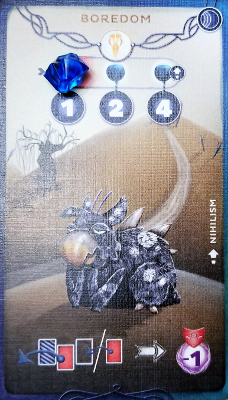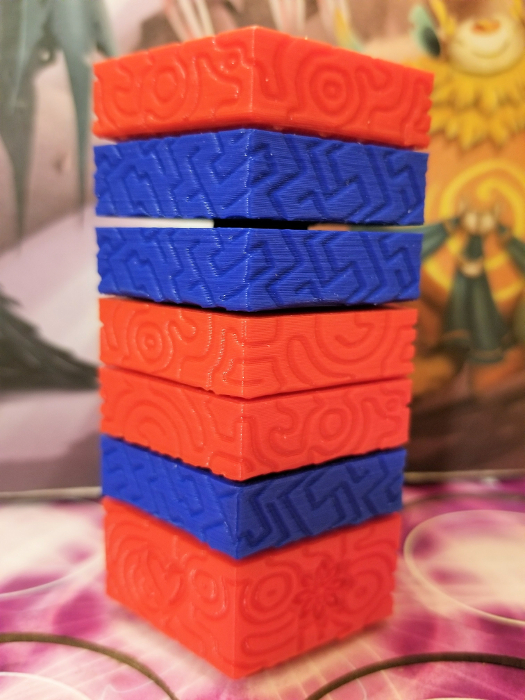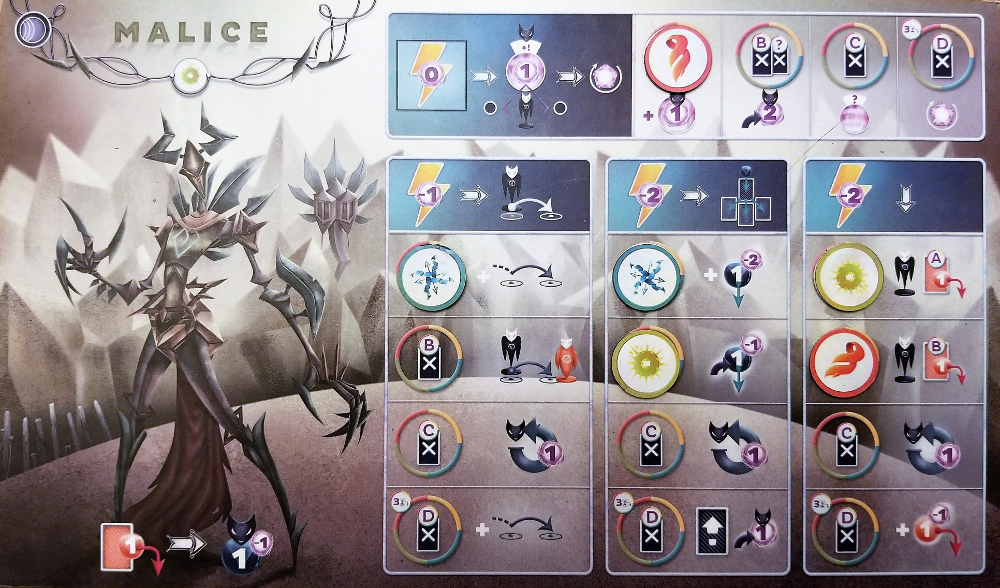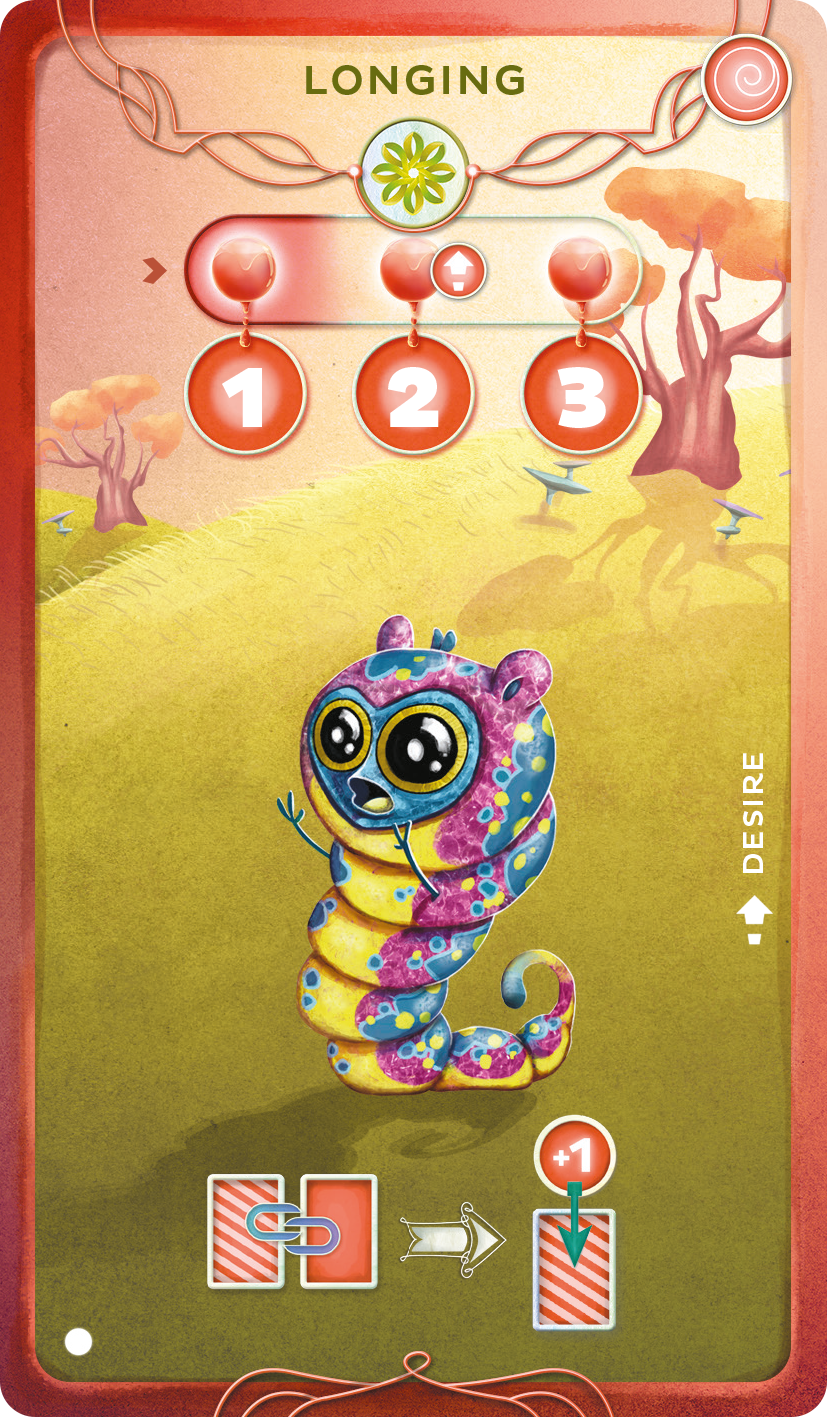Are you a happy person?
It’s a seemingly simple question on the surface. Yet the more you poke at it, the deeper and more complex it becomes. Is there an objective definition of happiness? Can anyone be happy all the time? Should they? How does one quantify and codify not just a slate of emotions but an entire state of mind? A state of being.
Put another way: we all experience moments of being happy. Mirth, excitement, merriment, contentment, and genuine joy. But while everyone is capable of having individually happy moments, whether you’re an overall happy person isn’t as clear-cut. We’ve all met upbeat people in dire straits and well-to-do people who are absolutely miserable. For every Tiny Tim, there is a Bojack Horseman.
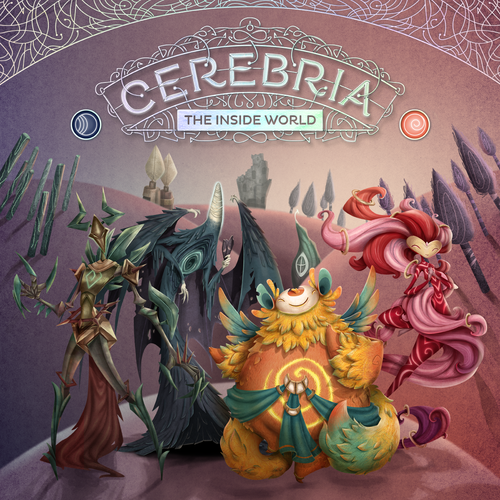 For most of us, whether our neutral, baseline state of being is a positive one or not is continually shaped by a lifetime of experiences. How we confront, adapt to, and cope with the trials of the outside world constantly affects how we perceive that world – and ourselves. In the real world, whether you’re a happy person or not is a messy, complicated state of affairs that’s at once personal and philosophical in nature.
For most of us, whether our neutral, baseline state of being is a positive one or not is continually shaped by a lifetime of experiences. How we confront, adapt to, and cope with the trials of the outside world constantly affects how we perceive that world – and ourselves. In the real world, whether you’re a happy person or not is a messy, complicated state of affairs that’s at once personal and philosophical in nature.
In the world of Cerebria, however, things are slightly more straightforward.
Cerebria is the latest title from the folks at Mindclash Games, creators of past games such as Trickerion and Anachrony. This time around they’ve moved away from worker placement and into more conflict-based territory. In this highly stylized setting, four players take sides as competing spirits attempting to gain dominance over their contested realm – which happens to be within the mind of a growing consciousness. Over the course of the game, both sides strive to control the territories within by deploying an array of negative and positive emotions to sway the various locations to their side.
It’s admittedly a bit esoteric, but think of it as if Inside Out was done by Tim Burton.
Diving into this mindful battle, one team begins as Team Bliss, controlled by the Spirits Harmony and Empathy, and representing the positive traits found within the realm. To achieve their goal of total happiness, they leverage Emotions such as Courage, Optimism, and Hope. Opposing them is Team Gloom, who are led by Malice and Anxiety; they summon forth the more negative aspects of one’s personality such as Bitterness, Fear, and Selfishness.
Each Spirit begins the game in a similar manner, with a player board and three randomly drawn Emotion cards from their own Emotion deck. The standard setup for Cerebria comes with a preconfigured deck of Emotion cards of their faction for each Spirit, but it’s evident almost immediately that Cerebria’s designers have left plenty of room for additional Spirit avatars and / or Emotions, along with being able to mildly customize your team’s Emotion decks as you become more comfortable.
In addition, everyone starts with small amount of the game’s two core resources: Willpower and Essence. Essence is almost exclusively used to bestow HP to Emotions when you add them to the board, whereas Willpower is used…pretty much to do everything else. Careful management of these resources is pivotal, as it’s much easier to spend them than it is to attain them. Though Cerebria is billed as an area control game, how to best spend your psychic capital may be even more central to the game’s moderate learning curve.
Rules-wise, though, Cerebria is less complicated than its theme makes it seem. Over the course of five rounds, teams (and the players on those teams) alternate taking turns. Each round affords your team with a set number of action points, allowing players to take between 1 and 3 actions a turn, divvied up however the team feels is in their best strategic interest at any given time.
There are nine possible actions a player can choose from in Cerebria, with only one limited to once per round. Yet while this sounds potentially daunting, the vast majority of those actions involve basic moves, including gathering resources such as Willpower, Essences, or Emotion cards; summoning, bolstering, or moving Emotions of your faction; or trying to eliminate an opposing Emotion from the board.
Of those actions, five of them are consistent throughout the game, whereas the remaining four can be upgraded on your player board for greater effect. In a move that’s both wise and clever, however, upgrading in and of itself isn’t an action. Instead, you merely pay to permanently upgrade the action you’re about to take before doing so, immediately granting you the newly powered-up effect. Not only does this keep the pacing of the game moving along smoothly, but it avoids encumbering players further in a system that’s short on both time and resources.
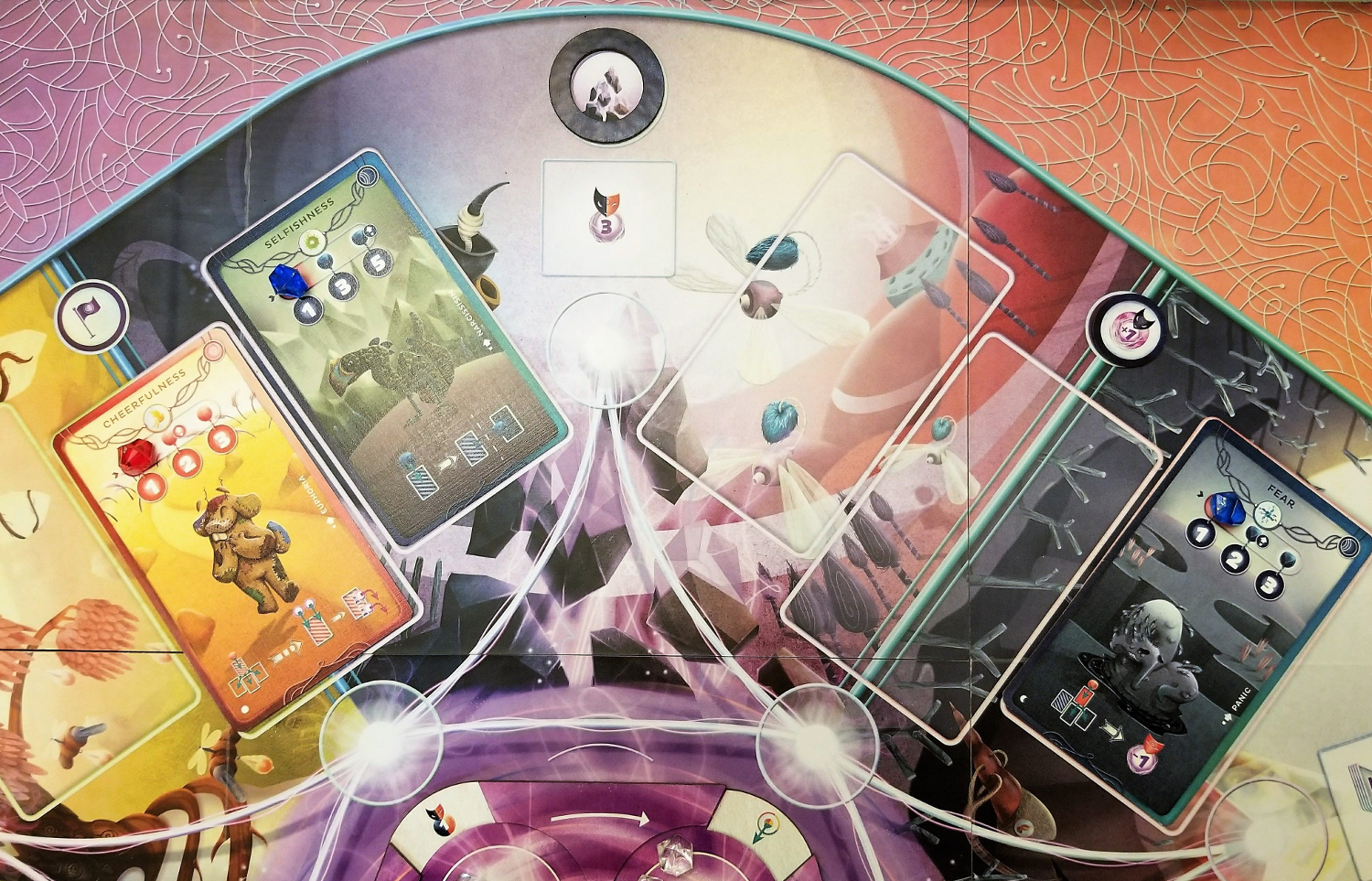
Uncontested, Team Gloom controls this Realm and the right Frontier. The left Frontier, being of equal strength, is neutral.
Prototype Shown
The goal in this artistically evocative duel of emotional motes is likewise more straightforward than it seems. Cerebria contains five Realms, each of which exists as a pair of card slots for summoning Emotion cards. Between each Realm lies a Frontier, which consists of three card slots (a center card plus one card from each adjoining Realm). Your primary motivation is to control as many of these Frontiers and Realms as possible. Doing so is as simple as adding up the strength of your Emotions present. If you have a higher total than the opposing side, then that part of this psychological worldscape is yours; if there’s a tie, then no one controls it.
Which makes sense really. If humans are good at anything, it’s ambivalence.
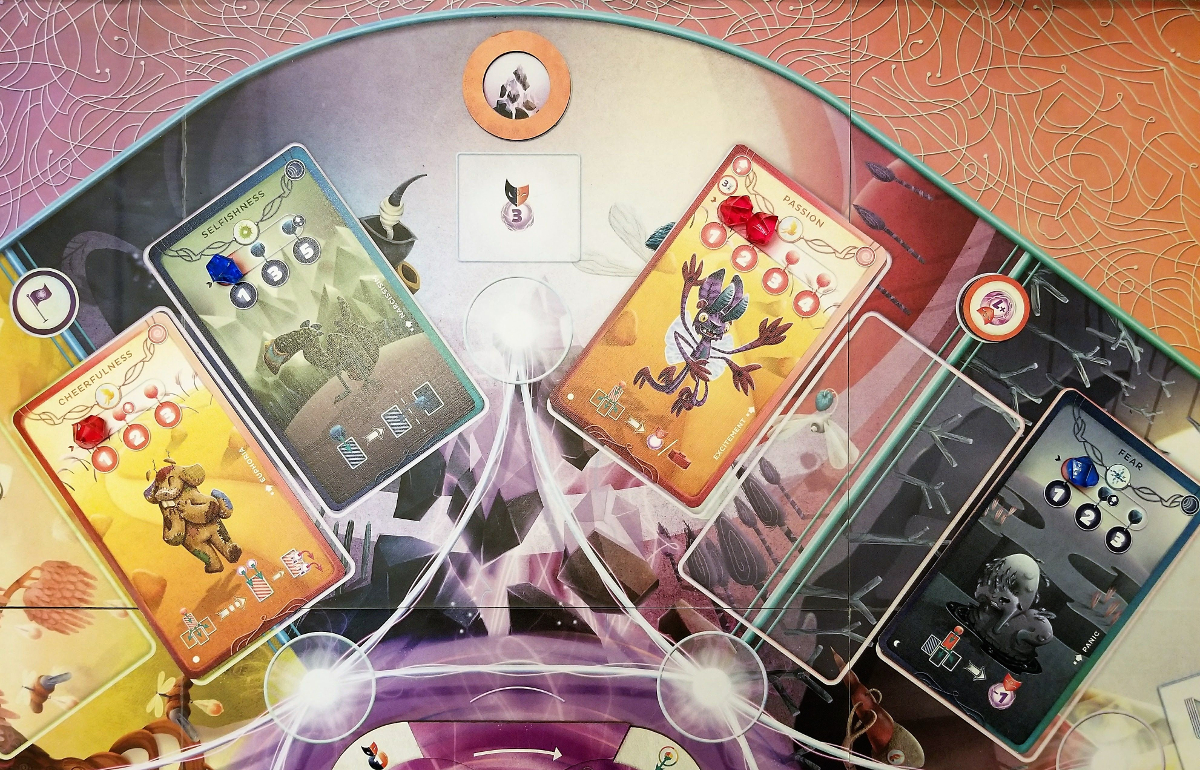
Upon invoking Passion, Team Bliss has gained control of both the Realm and right Frontier.
Prototype Shown
Controlling Frontiers and Realms bestows both short and long term benefits. Each Realm corresponds to one of the five static actions, and controlling its respective locale gives your team a slight (but welcomed) cost reduction when taking that action. Frontiers by contrast grant your team a bonus when it comes to extracting Willpower from the board’s central Origin spaces. These Origin spaces not only provide you with badly-needed Willpower and other minor bonuses, but they also control when scoring in the game occurs. More importantly, they also indirectly establish how you win.
Like the rest of Cerebria’s enigmatic setting, the game comes with a unique goal: to accumulate more Identity Fragments than the other side, which is represented using visually distinct 3-D obelisk pieces that stack up in the center of the board. Whenever an Origin space is emptied, a scoring event happens. This consists of players declaring whether or not they’ve achieved their current area control objectives.
See, throughout the game both sides are attempting to fulfill a common objective, such as controlling the most Realms or having the most Emotions on the board. Each team also has a similar hidden objective that they’re working towards. Whichever side achieves more of their goals than the other during a scoring gains an Identity Fragment. Then new goal cards are drawn, the Origin refills, and the game resumes.
The team with more Fragments on the tower at the end of the five rounds is the victor, with their side going on to become the dominant demeanor in this emerging consciousness.
What’s particularly appealing with this approach is that unlike many other area control games, Cerebria doesn’t mandate you try to control the entire board, or even to maintain control of the board for long periods of time. Instead it’s a much more fluid, target-based approach wherein your tactics are constantly changing to match your current objective.
Sure, controlling more territory gives you better odds, but that’s not the main focus of the game.
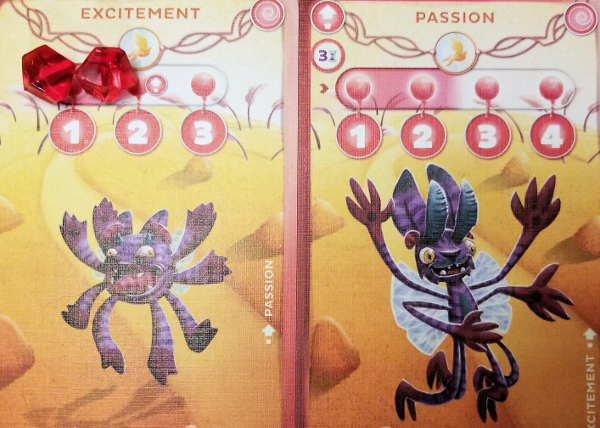
Properly invested, some Emotions can unlock even more powerful Emotion cards to play in later rounds.
Prototype Shown
Cerebria requires a degree of tactical agility in order to pivot from one goal to the next, and it unquestionably rewards players who enjoy constantly having to adjust their strategy. For instance, depending on the actions of you and the opposing team, it’s entirely possible to have multiple scoring moments in one round and none in the next. This gives the game a striking amount dynamism to contend with. Yet it never devolves into your standard fare of fast-paced skirmishes. In this world, both planning and adaptability are essential.
In the same way that the game exudes its theme through iconic and masterful artwork, it is this trait that goes to the mechanical heart of what makes Cerebria so notable. Cerebria is arguably more rules-lite than either of the company’s previous two games, but don’t mistake that to mean it’s simplistic. While the iconography of the game can reach Race for the Galaxy level befuddlement at first glance, the majority of its true complexity resides in the gameplay itself.
Indeed, Cerebria is undeniably the sort of game where it will take a couple playthroughs to fully grasp the nuances of what each side is capable of doing, how to leverage those to your side’s advantage, and how to try to minimize the actions of your opponents. Though this is also indicative of a game with a fair amount of depth and replayability once players are familiarized with the setting.
The one sticking point some may have with the game is its reliance on being a team-based affair. Although the designers have the intention of implementing new gameplay options, including solo mode, 1 v 1, and two person co-op, Cerebria has principally and unapolagetically been designed for four people.
And it shows. Cerebria does a remarkable job setting a stage where both players on a team aren’t just able to contribute to their side’s efforts – it’s required. The fact that each person is limited to three actions per turn, that teammates must alternate turns, and that no one Spirit is capable of handling everything their opponent can throw at them, Cerebria ensures not only that you must work in tandem with another Spirit to be effective, but it also makes it difficult for one person to alpha gamer all over their team.
The end result of all these choices leaves you with a deeply quixotic world filled with ample room for both calculated decision-making and a stunning, vivid theme. Delight may not be a playable Emotion in the game, but it’s certainly present in this box.
Cerebria is a rich, esoteric world of emotion-filled conflict and collaboration that, while occasionally confounding, brings a distinctly unique mindset to team-based area control games. Rather than relying on brute strength or indiscriminate decisions, this game both values and requires well-timed, precision-based tactics to sway the outcome of the burgeoning consciousness you’re fighting over. With Cerebria Mindclash continues its tradition of games with excellent components, clever themes, and complex-yet-intriguing systems to explore. And this may be their most ambitious title yet.
To gauge your own emotional response to Cerebria, you can feel it out right now over on Kickstarter!
This project has earned the Seal of the Republic
Photo Credits: Cerebria cover and artwork by Mindlcash Games.


